Do you have a question about the ActronAir Advance Series and is the answer not in the manual?
Details the purpose and scope of the installation and commissioning guide.
Instructions for inspecting the unit and accessories upon receipt for any damage.
Emphasizes installer's responsibility for compliance with local codes and regulations.
Describes the highly efficient refrigeration circuit design and its components.
Details the evaporator section, including EC fans and their benefits for airflow.
Highlights the condenser section's components like EC axial fans and inverter compressor.
Explains the electrical section, including control panels and VSD enclosure.
Discusses the unit's robust construction, including galvanized steel cabinet and coil guards.
Notes the unit's suitability for residential and commercial applications.
Urges technicians to minimize refrigerant emissions and handle refrigerants responsibly.
Highlights the unit's use of zero ozone-depleting refrigerant and energy efficiency.
Warns about live electrical components and the need for qualified technicians.
Advises waiting after power isolation due to capacitors holding residual voltage.
Caution regarding rotating fans, pinch points, and sharp edges requiring PPE.
Stresses the importance of assessing work areas and familiarizing with unit parts.
Guidelines on recovering, recycling refrigerants and service equipment usage.
Key items to consider before starting the unit installation process.
Recommendations for unit placement, anti-vibration pads, and clearances.
Safety precautions for handling mildly flammable R-32 refrigerant.
Information on how to download operation manuals from the website.
Diagram and identification of components on the single-phase control panel.
Diagram and identification of components on the three-phase control panel.
Details of the Compressor Variable Speed Drive (VSD) assembly components.
Provides overall dimensions and mounting details of the outdoor unit.
Specifies required clearances for service access and optimal airflow.
Details the method for lifting the unit using a crane.
Explains the procedure for lifting the unit using a forklift.
Guidelines for connecting and brazing field pipes, including precautions.
Safety information and handling procedures specific to R-32 refrigerant piping.
Steps for pressurizing the system and performing a pressure test.
Detailed steps for performing a triple evacuation of the refrigeration system.
Essential safety warnings for working with live electrical components.
Indicates the location of specific wiring diagrams for installation.
Details power supply compatibility and requirements for the unit.
Information on compressor voltage balance and crankcase heater.
Illustrates the main electrical connections for the split unit system.
Provides instructions for correctly connecting and shielding data cables.
Lists allowed combinations of different wall controller types.
Details the recommended wiring setup for wall controllers.
Presents an alternative wiring setup for wall controllers.
Wiring details for LR7-1, LC7-2, and NEO wall controllers.
Wiring instructions for LM-RS-2 and AERSS optional sensors.
Explains how to navigate the unit's menu for settings and status.
Information on configuring compressor type and capacity settings.
Details on setting the control source for BMS and third-party systems.
Controlling compressor and fan using 0-10V analogue signals.
Controlling compressor externally with fixed indoor fan speed.
Controlling indoor fan externally with fixed compressor speed.
Using run and fault indication outputs for system status.
Enabling unit ON/OFF control via an external remote switch.
Provides fan performance data and application curves for different models.
Table listing factory refrigerant charge for various models.
Procedures for checking subcooling and superheat for optimal performance.
Instructions for recording the final refrigerant charge on unit labels.
Details on pipe sizes, lengths, and height differentials for refrigeration circuits.
Provides factory charge, additional charge, and maximum charge details.
General guidance on regular servicing by licensed technicians.
Checklist of tasks for annual maintenance of the unit.
Procedures and precautions for cleaning the condenser coils.
Details the purpose and scope of the installation and commissioning guide.
Instructions for inspecting the unit and accessories upon receipt for any damage.
Emphasizes installer's responsibility for compliance with local codes and regulations.
Describes the highly efficient refrigeration circuit design and its components.
Details the evaporator section, including EC fans and their benefits for airflow.
Highlights the condenser section's components like EC axial fans and inverter compressor.
Explains the electrical section, including control panels and VSD enclosure.
Discusses the unit's robust construction, including galvanized steel cabinet and coil guards.
Notes the unit's suitability for residential and commercial applications.
Urges technicians to minimize refrigerant emissions and handle refrigerants responsibly.
Highlights the unit's use of zero ozone-depleting refrigerant and energy efficiency.
Warns about live electrical components and the need for qualified technicians.
Advises waiting after power isolation due to capacitors holding residual voltage.
Caution regarding rotating fans, pinch points, and sharp edges requiring PPE.
Stresses the importance of assessing work areas and familiarizing with unit parts.
Guidelines on recovering, recycling refrigerants and service equipment usage.
Key items to consider before starting the unit installation process.
Recommendations for unit placement, anti-vibration pads, and clearances.
Safety precautions for handling mildly flammable R-32 refrigerant.
Information on how to download operation manuals from the website.
Diagram and identification of components on the single-phase control panel.
Diagram and identification of components on the three-phase control panel.
Details of the Compressor Variable Speed Drive (VSD) assembly components.
Provides overall dimensions and mounting details of the outdoor unit.
Specifies required clearances for service access and optimal airflow.
Details the method for lifting the unit using a crane.
Explains the procedure for lifting the unit using a forklift.
Guidelines for connecting and brazing field pipes, including precautions.
Safety information and handling procedures specific to R-32 refrigerant piping.
Steps for pressurizing the system and performing a pressure test.
Detailed steps for performing a triple evacuation of the refrigeration system.
Essential safety warnings for working with live electrical components.
Indicates the location of specific wiring diagrams for installation.
Details power supply compatibility and requirements for the unit.
Information on compressor voltage balance and crankcase heater.
Illustrates the main electrical connections for the split unit system.
Provides instructions for correctly connecting and shielding data cables.
Lists allowed combinations of different wall controller types.
Details the recommended wiring setup for wall controllers.
Presents an alternative wiring setup for wall controllers.
Wiring details for LR7-1, LC7-2, and NEO wall controllers.
Wiring instructions for LM-RS-2 and AERSS optional sensors.
Explains how to navigate the unit's menu for settings and status.
Information on configuring compressor type and capacity settings.
Details on setting the control source for BMS and third-party systems.
Controlling compressor and fan using 0-10V analogue signals.
Controlling compressor externally with fixed indoor fan speed.
Controlling indoor fan externally with fixed compressor speed.
Using run and fault indication outputs for system status.
Enabling unit ON/OFF control via an external remote switch.
Provides fan performance data and application curves for different models.
Table listing factory refrigerant charge for various models.
Procedures for checking subcooling and superheat for optimal performance.
Instructions for recording the final refrigerant charge on unit labels.
Details on pipe sizes, lengths, and height differentials for refrigeration circuits.
Provides factory charge, additional charge, and maximum charge details.
General guidance on regular servicing by licensed technicians.
Checklist of tasks for annual maintenance of the unit.
Procedures and precautions for cleaning the condenser coils.
| Brand | ActronAir |
|---|---|
| Model | Advance Series |
| Category | Air Conditioner |
| Language | English |
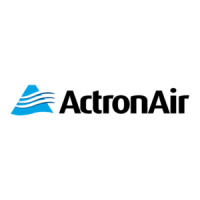
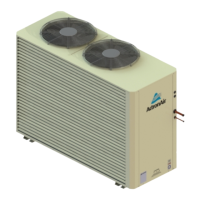
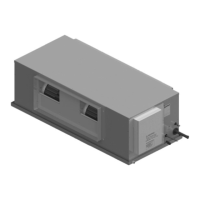
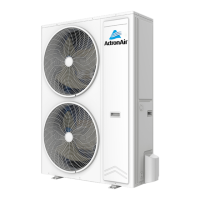






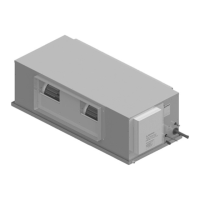

